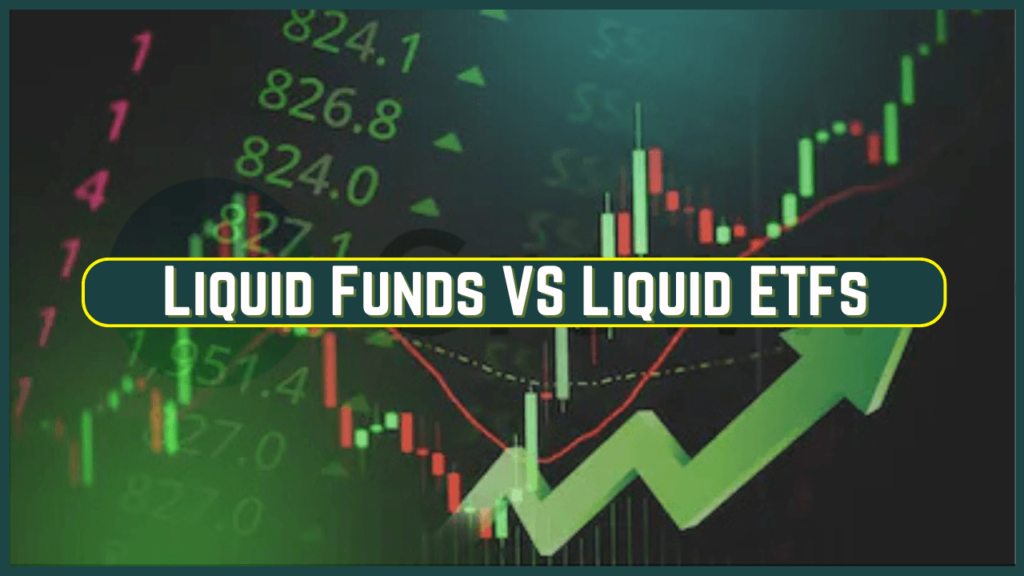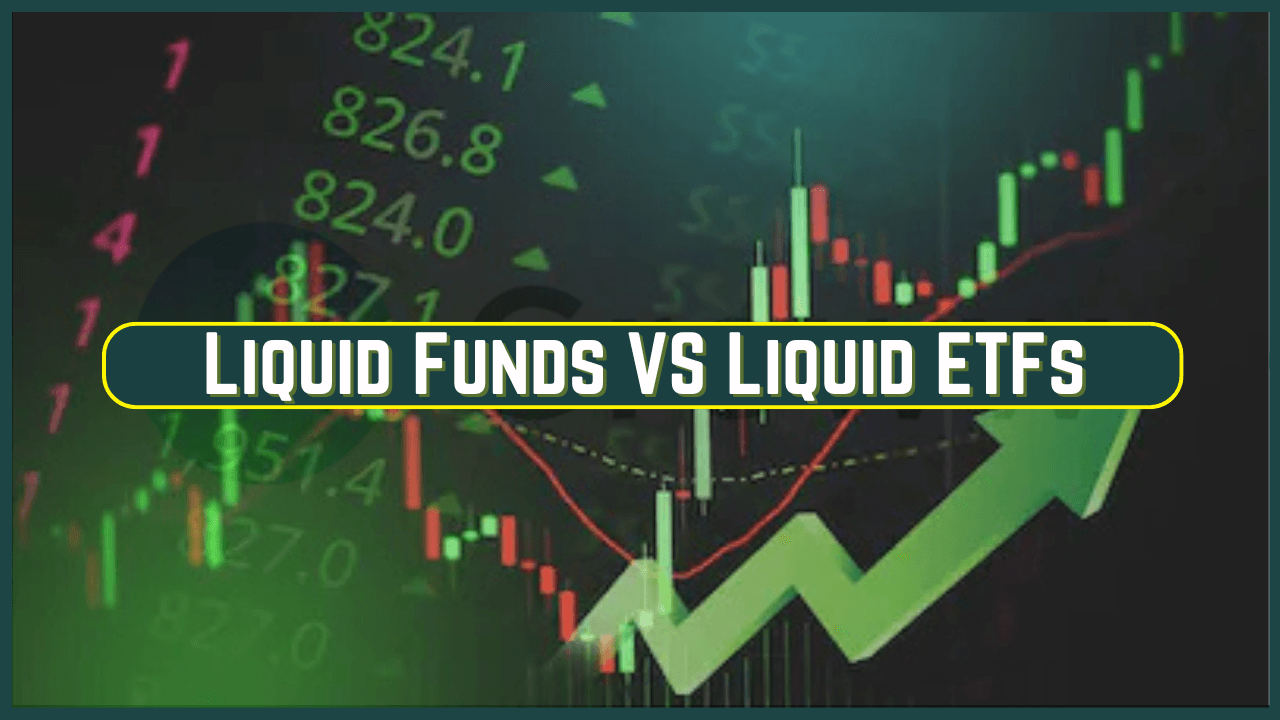Liquid funds and liquid ETFs are widely popular short-term investment options because they offer comparatively safe, risk-free avenues for investors to put their money into the market for short durations. However, while both are generally low-risk funds, they offer vastly different approaches in structure, liquidity, and investment suitability.
This blog will discuss the difference between liquid funds and liquid ETFs, their features, benefits, and how to choose the right one based on your investment needs.

What Are Liquid Funds?
Liquid funds is a debt mutual fund that invests in money market instruments with a short-term horizon, including treasury bills, commercial papers, and certificates of deposit. Liquidity is provided on an immediate basis, but returns are relatively better than those offered by the savings bank account.
Key Features of Liquid Funds
- Low Risk: Investment goes into high-credit-quality instruments.
- Short Maturity Period: It usually runs between 1 to 91 days.
- Daily NAV (Net Asset Value): NAV is calculated daily, which means that the investor can track the value of his investment in real-time.
- Redemption Time: The fund is credited usually within one working day.
Who Should Invest in Liquid Funds?
- Investors looking for slightly better returns than a savings account.
- Those needing high liquidity without taking significant risks.
What Are Liquid ETFs?
Liquid ETFs are essentially exchange-traded funds that primarily invest in money market instruments. Similar to liquid funds, they do not, however, trade on stock exchanges. Therefore, the units can be bought and sold during trading hours.
Key Features of Liquid ETFs
- Market-Traded: Units are traded on stock exchanges.
- Low Expense Ratio: Lower than liquid funds as it has a passive management structure.
- Real-Time Liquidity: The investor can exit his position at any time during market hours.
- Price Fluctuation: Prices may vary slightly during the day due to demand and supply dynamics.
Who Should Invest in Liquid ETFs?
- Investors with a Demat account who are familiar with stock market operations.
- Those seeking real-time liquidity and lower expense ratios.
Comparison Table: Liquid Funds vs. Liquid ETFs
| Feature | Liquid Funds | Liquid ETFs |
|---|---|---|
| Structure | Mutual Fund | Exchange-Traded Fund |
| Trading Platform | Purchased via AMC or mutual fund platforms | Traded on stock exchanges |
| Expense Ratio | Higher than Liquid ETFs | Lower due to passive management |
| Liquidity | Redeemable through AMC; funds in 1 day | Real-time liquidity during trading hours |
| NAV Updates | Calculated daily | Price fluctuates in real-time |
| Investment Suitability | Ideal for new or passive investors | Suitable for active market participants |
| Minimum Holding Period | None | None |
| Demat Account Requirement | Not required | Mandatory |
Differences in Depth
1. Trading Mechanism
- Liquid Funds: Bought and sold directly from mutual fund houses or platforms like Groww and Zerodha. NAV is calculated at the end of the day, and units are redeemed based on this value.
- Liquid ETFs: Traded on stock exchanges throughout the day, allowing investors to take advantage of real-time pricing.
2. Liquidity
- Liquid Funds: Investors can typically redeem their investments within 1 business day.
- Liquid ETFs: Offer instant liquidity during market hours, provided there’s sufficient trading volume.
3. Expense Ratio
- Liquid Funds: Actively managed, leading to higher expense ratios (usually around 0.2% to 0.5%).
- Liquid ETFs: Passively managed, resulting in lower expense ratios (as low as 0.1%).
4. Access and Requirements
- Liquid Funds: Can be accessed by anyone without the need for a Demat account.
- Liquid ETFs: Require a Demat account and familiarity with stock market trading.
Advantages of Liquid Funds
- Ease of Access: No Demat account is required, making it easier for new investors to get started.
- Low Risk: Investments are made in highly rated, short-term securities.
- Flexible Redemption: Investors can withdraw funds as needed with minimal hassle.
Advantages of Liquid ETFs
- Real-Time Trading: Perfect for investors who want instant access to their money during trading hours.
- Low Expense Ratio: Offers cost efficiency for long-term holdings.
- Transparency: Prices are determined by market demand and supply, making them transparent and predictable.
Which One Should You Choose?
Choose Liquid Funds If:
- You are new to investing and prefer a simpler, less technical platform.
- You need access to your funds within one working day.
- You prefer to invest without opening a Demat account.
Choose Liquid ETFs If:
- You already have a Demat account and understand how to trade on stock exchanges.
- You want real-time liquidity and lower expense ratios.
- You are looking for a transparent, market-driven investment.
Real-Life Example
Scenario 1: Emergency Savings
Ravi is a salaried employee who wants to park his emergency fund safely. He chooses liquid funds because they have a slightly better return than that of a savings account, and he does not need the amount immediately.
Scenario 2: Active Trader
Priya is an active stock market investor who uses liquid ETFs for parking short-term surplus cash. She appreciates the instant sale of units during trading hours.
Tax Implications
Both liquid funds and liquid ETFs are treated as debt investments for taxation purposes:
- Short-Term Capital Gains (STCG): Taxed as per the investor’s income slab for holdings under three years.
- Long-Term Capital Gains (LTCG): Taxed at 20% with indexation benefits for holdings over three years.
Conclusion
Liquid funds are excellent for parking short-term surplus funds, as are liquid ETFs, although the choice would depend on the investment goals, the risk profile of the investor, and his market involvement. Liquid funds will be best for beginners or simple-minded investors; liquid ETFs are more apt for active investors who seek immediate liquidity and relatively lower costs.
Take time to assess your requirements and seek the advice of a financial advisor if necessary. With the right choice, you can make the most of your short-term investments while ensuring safety and liquidity.
FAQs
Are liquid ETFs riskier than liquid funds?
Both are low-risk investments, but liquid ETFs may have slightly higher price fluctuations due to market trading.
Do I need a Demat account to invest in liquid funds?
No, a Demat account is not required for liquid funds, but it is mandatory for liquid ETFs.
Can I redeem liquid funds instantly?
Liquid funds typically credit your account within one business day, while liquid ETFs offer real-time redemption during market hours.
Which option has a lower expense ratio?
Liquid ETFs generally have a lower expense ratio compared to liquid funds.
Are both options suitable for short-term investments?
Yes, both liquid funds and liquid ETFs are designed for short-term investments, offering high liquidity and low risk.













This provides information
muito bom